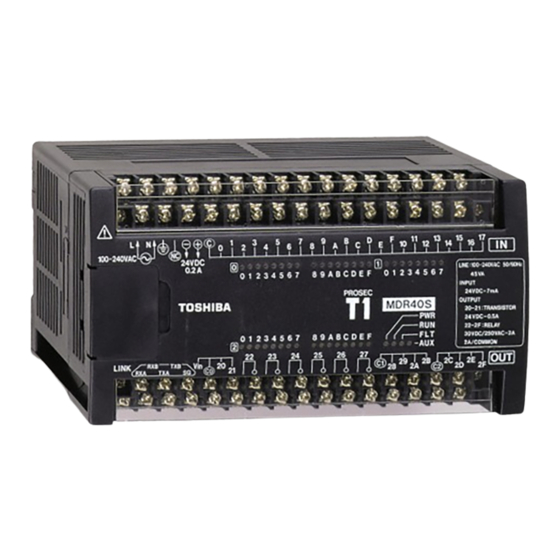Advertisement
Quick Links
Download this manual
See also:
Installation Manual
In Touch With Tomorrow
Programmable Controllers
MODEM COMMUNICATIONS WITH THE T1 AND T2E/T2N
USING T-PDS WINDOWS FOR DIAL–UP COMMUNICATIONS WITH TOSHIBA
T1 AND T2E/T2N PROGRAMMING PORT
Master Computer
Different
Ph. Numbers
Stored in T-PDS
Software
Toshiba PLC users can expand their remote diagnostics and remote programming capabilities
by using Hayes
compatible modem communications over the Public Switched Telephone
Network with standard analog phone lines and standard modems. Please note that "analog" line
means a normal dial-in dial–out phone line similar to the ones that you have at home (i.e., about
48Vdc open circuit voltage with about 110Vac ring voltage). This does not include the digital
phone lines in most offices that use modern digital PBX systems. Plugging a modem directly into
one of these digital office lines may destroy the modem.
We used US Robotics 56K Sportster
Hayes compatible modem will work. Here is the list of equipment that you need for modem
communications with the PLC's programming ports:
Accessories For T2E/T2N Modem Communications (with programming port):
PC Side:
a standard "straight-through" 9-25 pin RS-232 serial cable
a
9600 baud external modem.
PLC Side:
a standard "straight-through" 9-25 pin RS-232 serial cable
a
9600 baud external modem.
See Note 1 on page 5
TOSHIBA INTERNATIONAL CORPORATION
Modem
Telephone
Line
Telephone
Line
external modems for our tests, but just about any external
13131 West Little York Road
PH. 800 231- 1412, 713-466-0277
E-Mail plc@tic.toshiba.com
T2E/T2N PLC
Modem
RS232
Modem
w/Null
T1/T1S PLC
Modem
Adapter
RS232
Houston, TX 77041
FAX 713-466-8773
March 1998
T1
T1
T1
T1
Advertisement

Summary of Contents for Toshiba T1
- Page 1 Ph. Numbers Stored in T-PDS Software Toshiba PLC users can expand their remote diagnostics and remote programming capabilities by using Hayes compatible modem communications over the Public Switched Telephone Network with standard analog phone lines and standard modems. Please note that “analog” line means a normal dial-in dial–out phone line similar to the ones that you have at home (i.e., about...
- Page 2 There are 3 Setup Steps: STEP 1: CONFIGURE THE PLC First, let’s set up the PLC’s Computer Link parameters. Go Online with the T1 or T2E/T2N using the normal “Direct” method. We will need to open the System Parameters screen as shown below:...
- Page 3 Click on the “Computer Link” button in the System Parameters screen, and the “ComputerLink Setup” menu will appear. Select a station number for the PLC, then click the “Communication Parameter” button . Select “NON” parity setting, and then click the “OK” buttons. When the “Write OK”...
- Page 4 Now let’s go to the Modem Control box and finish the T-PDS configuration. The Modem Control box is a handy database that will store a remote site name, modem initialization parameters, and the phone number of the remote site. You can move between the fields using the TAB key. The most important parameter here is the “Initialize”...
- Page 5 If you are using a T1, remember to attach the null-modem module to the modem’s RS-232 cable. Also, in the T1 version 1.2 as well as the Super T1-40, register SW038 is the Computer Link Response Delay setting which can be used with the default setting of 30 (for a 300 ms delay) or can be lowered if needed.
- Page 6 If you have one of these PLCs and would like to use modem communications, you must use a modem that supports odd parity. This will apply if you have a T1 with firmware version earlier than 1.2, or any of the T2 series that is not a T2E/T2N. Most T3’s will also require an odd parity modem.







